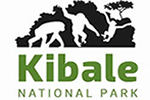Kibale National Park is mainly a medium-altitude transitional moist evergreen forest with characteristics of both dry tropical and wet tropical rain forests. A big part of the park is also
occupied by grassland communities. The dominant species are Pennisetum purpureum, Imperata cylindrica and Cymbopogon afronardus. These generally occupy hilltops and are probably a result of human settlement fires occasionally set by poachers.
The forest cover is broadly classified as moist evergreen in the north and moist semi-deciduous in the south. In the central part, the high forest is a mixture of deciduous and evergreens with
evergreen tree species being predominant. Trees rise to over 55m and exhibit a semi-closed canopy of stratified tree crowns. The undergrowth is sparse and characterised by shade tolerant herbs and shrubs such as Palisota schwenfurthii, Pollia condensata and a variety of ferns and broad-leaved forest grasses.
There is also a dense growth of herbaceous and non-woody vegetation dominated by Acanthus species. This occurs in the more open secondary forest in the northern part of KNP, where
large trees were removed by selective felling which was practiced up to 1969.
Three hundred and fifty one forest tree species (28% of the country’s total) have been recorded in the park (Howard et al., 1996). The northern, central and southern parts of KNP vary in dominant tree species. In the north (> 1500 m altitude) Parinari excelsa dominates with Strombosia scheffleri, Aningeria altissima, Newtonia buchananii, Olea welwitschii and Carapa grandifolia as typical associates.
In the centre (1200-1500 m altitude), the forest is mixed, dominated by Chrysophyllum gorungosanum, Celtis africana, Markhamia platycalyx, Piptadeniastrum africanum, Newtonia
buchananii, Chrysophyllum albidum and Diospyros abyssinica with Parinari excelsa occurring in low numbers. The south (1100-1200 m altitude) is dominated by Olea welwitschii, Pterygota braedii and a mixture of Lovoa swynnertonii, Diosyros abssinica and Markhamia platycalyx forests.
Pure stands of ironwood (Cynometra alexandria) occupy the southern river valleys and lower altitudes with Pandanus spp., Celtis durandii, Celtis africana, Diospyros abyssinica and Warbugia ugandensis sparsely present. The flat terrain which is often flooded has thick stands of palms including Phoenix reclinata, Raffia and Screw Palms (Howard, 1991).
Most species occur elsewhere in Uganda. However some are noteworthy because their occurrence in Kibale is part of a limited range in western Uganda, e.g. Elaeophorbia spp., Cola congolana,
Tabemaemontane odoratissima and Hannoa longipes. Non-timber trees of economic importance include wild robusta coffee (Coffea canephora) (Langdale Brown et al., 1964; Kingston, 1967;
Osmaston, 1959; Wing and Bus, 1970; Kasenene, 1987; Howard, 1991).
Endangered timber species include Milicia exclesa, Cordia millenii, Entandrophragma angolensis and Lovoa swynnertinii.
Fauna includes threatened and near threatened species such as elephant (Loxodonta africana), leopard (Panthera pardius), chimpanzee (Pan troglodytes), red colobus monkey (Colobus badius)
and L’Hoest’s monkey (Cercopithecus l’hoesti).
Kibale fauna is documented, compared to many other forests in Uganda. Of particular interest are thirteen species of non-human primates (67% of the country’s total species). Like chimpanzees, Kibale is home to red colobus monkeys, in what is probably their last viable population in Uganda (IUCN, 1988).
The avifauna and invertebrates of Kibale are also varied. KNP is listed as one of the thirty Important Bird Areas in Uganda, falling under the categories A1, A2 and A3 (Byaruhanga, A. et al., 2001).
At least 372 species of birds, occurring in 58 families, have been listed. Those noteworthy due to their limited distribution or threatened status include: olive long-tailed cuckoo, western green
tinker bird, Willcock’s’ honeyguide, collared apalis, red-faced woodland warbler, white-bellied crested flycatcher, blue-headed sunbird, purple-breasted sunbird, dusky crimson-wing, white-
naped pigeon, papyrus gonolek, white-checked olive back, and the Kibale Prigogine’s ground thrush (Turdus kibalensis) which is not seen outside Kibale. Common birds include black and white
casqued hornbill, crowned eagle, great blue turaco and grey parrot.
Reptiles and amphibians are also abundant but relatively little is known about them. The invertebrates include 45 species of forest swallowtail and Charaxes butterflies.
